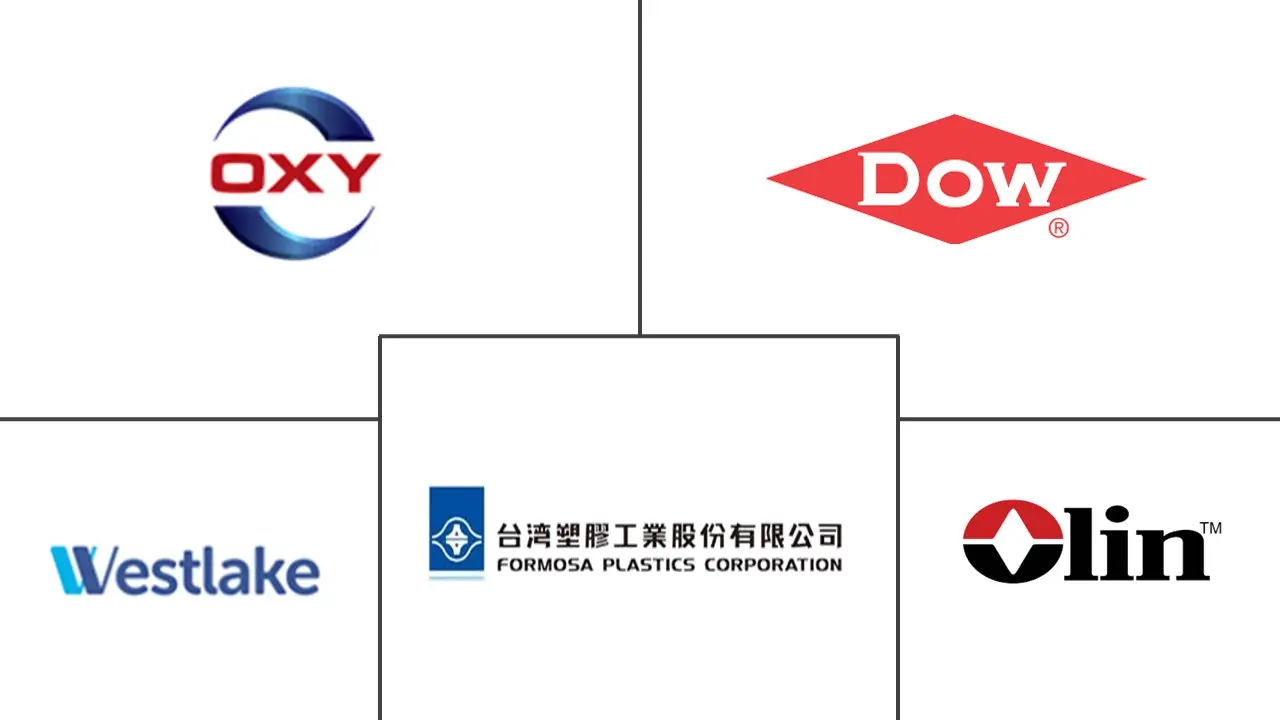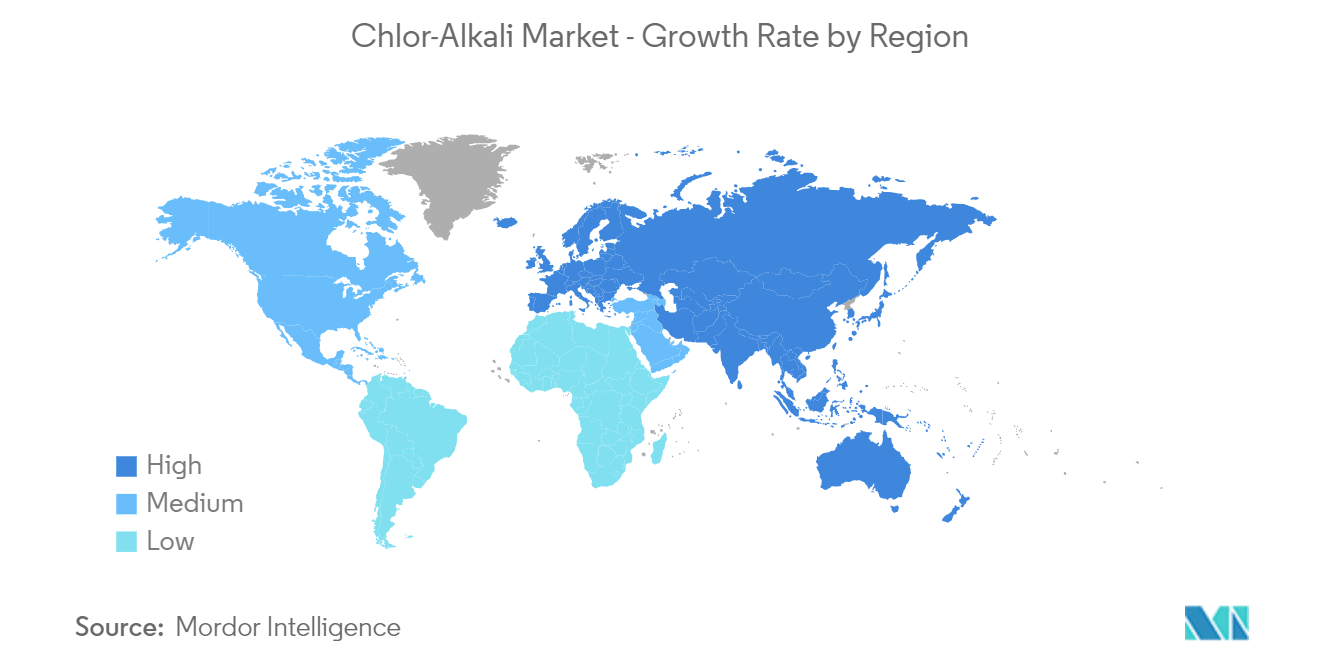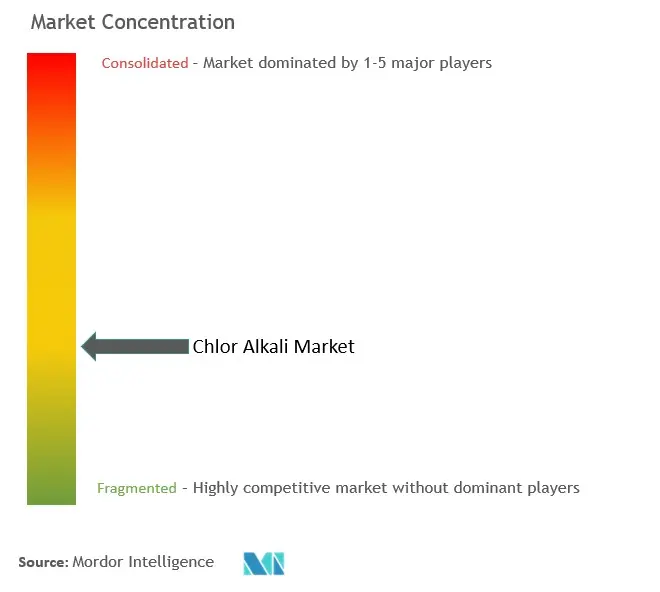Chlor Alkali Market Size

| Study Period | 2019 - 2029 |
| Base Year For Estimation | 2023 |
| CAGR (2024 - 2029) | 3.00 % |
| Fastest Growing Market | South America |
| Largest Market | Asia Pacific |
| Market Concentration | Medium |
Major Players
*Disclaimer: Major Players sorted in no particular order |
Chlor Alkali Market Analysis
The Chlor-alkali Market size is estimated at 269.84 Million tons in 2024, and is expected to reach 317.49 Million tons by 2029, growing at a CAGR of greater than 3% during the forecast period (2024-2029).
The COVID-19 pandemic negatively affected the demand for chlor alkali across the world. During the pandemic, demand for chlor alkali products decreased in sectors such as construction, automotive, and manufacturing due to lockdowns, supply chain disruptions, and reduced economic activity. This decline in demand affected the consumption of chlorine for PVC production. However, as countries began to ease lockdown restrictions and reopen their economies, the demand for chlor alkali products rebounded. Industries that had experienced disruptions gradually resumed operations, leading to increased demand for chlorine and sodium hydroxide.
- The major factors driving the market's growth are the surging demand in chemical manufacturing and the growing demand for polyvinyl chloride (PVC).
- However, the environmental impact and stringent environmental regulations are expected to hinder the chlor alkali market.
- The increasing investment in research and development and exploration of new applications of chlor alkali are expected to offer new growth opportunities to the industry.
- Asia-Pacific is likely to hold the largest market share due to the large-scale production and consumption of chlor alkali products and their derivatives.
Chlor Alkali Market Trends
The Organic Chemical Segment to Dominate the Market
- Chlorine, produced as a co-product in the electrolysis of brine during chlor alkali production, serves as a crucial feedstock in producing numerous organic chemicals. Chlorine is a versatile building block in organic synthesis, forming the basis for the production of chlorinated solvents, plastics, agrochemicals, pharmaceuticals, and other organic compounds.
- The largest consumer of chlorine is the plastics industry, particularly the production of polyvinyl chloride (PVC). PVC is widely used in construction materials, packaging, automotive parts, and various consumer goods. The demand for PVC drives significant consumption of chlorine, making the organic chemicals segment a major contributor to the chlor alkali market.
- Chlorine production and consumption continue to increase in its various end-user industries. According to Euro Chlor, by the end of December 2023, chlorine production in Europe climbed to 609,418 tonnes. On average, in December 2023, there was a decrease of 1.7% in daily production compared to November 2023 (which saw 19,659 tonnes) but an increase of 18.6% compared to December 2022 (with 16,573 tonnes).
- According to the data published by the Euro Chlor, Germany produced 5.4 million metric tons of chlorine in 2022, accounting for the country's largest chlorine production capacity.
- As per the BASF Report 2023, chemical manufacturing worldwide, not including the pharmaceutical industry, is anticipated to expand by 2.7% in 2024, a rate higher than the year before (2023: +1.7%). In China, which holds the top position in the global chemical market, a decrease in growth but still significant expansion of 4.0% compared to the robust growth in the year prior (2023: +7.5%) is anticipated.
- Thus, the factors mentioned above are expected to increase the demand for chlor alkali in the upcoming period.

Asia-Pacific to Dominate the Market
- Asia-Pacific is home to rapidly growing economies such as China, India, and Southeast Asia, which are experiencing robust industrial growth. This growth drives the demand for chlor alkali products in various industries, including construction, manufacturing, chemicals, and textiles.
- Asia-Pacific has a large manufacturing base, particularly in industries that are significant consumers of chlor alkali products such as PVC, textiles, and chemicals. The region's manufacturing sector accounts for a significant portion of global chlor alkali consumption.
- Additionally, as per China's State Council Information Office, the total profits of China's leading textile companies increased by 7.2% Y-o-Y in 2023. In the same year, China's exports of textiles and clothing reached USD 293.6 billion. The exports of textiles and clothing began to grow again in December 2023, showing a 2.6% increase from the previous year.
- Moreover, according to Invest India, India accounts for 4% of the worldwide textile and clothing trade. It is projected to reach USD 250 billion in textile manufacturing and USD 100 billion in exports by 2030.
- Furthermore, according to the data released by the National Bureau of Statistics of China, 6.98 million metric tons of plastic products were produced in December 2023 in China.
- Thus, the factors mentioned above are expected to increase the market demand for chlor alkali in Asia-Pacific.

Chlor-alkali Industry Overview
The chlor alkali market is partially fragmented. The major players in the market (not in any particular order) include Olin Corporation, Occidental Petroleum Corporation, Formosa Plastics Corporation, Dow, and Westlake Vinnolit GmbH & Co. KG.
Chlor-alkali Market Leaders
-
Olin Corporation
-
Occidental Petroleum Corporation
-
Westlake Chemicals Corporation
-
Dow
-
Formosa Plastics Corporation
*Disclaimer: Major Players sorted in no particular order

Chlor-alkali Market News
- February 2024: INEOS Inovyn launched its Ultra Low Carbon (ULC) Chlor-Alkali product range. This includes caustic soda, caustic potash, and chlorine. The ULC product range may significantly reduce the CO2 footprint by up to 70%.
- June 2022: OxyVinyls, the chemical division of Occidental Petroleum, announced its plans for expansion and modernization of its chlor alkali plant in La Porte, Texas, with an investment of USD 1.1 billion. This involves expanding and upgrading present system equipment and processes with the new equipment that utilizes membrane cell technology.
Chlor Alkali Market Report - Table of Contents
1. INTRODUCTION
- 1.1 Study Assumptions
- 1.2 Scope of the Study
2. RESEARCH METHODOLOGY
3. EXECUTIVE SUMMARY
4. MARKET DYNAMICS
-
4.1 Drivers
- 4.1.1 Surging Demand in Chemical Manufacturing
- 4.1.2 Growing Demand for Polyvinyl Chloride (PVC)
-
4.2 Restraints
- 4.2.1 Environmental Impact and Stringent Environmental Regulations
- 4.3 Industry Value Chain Analysis
-
4.4 Porter's Five Forces Analysis
- 4.4.1 Bargaining Power of Suppliers
- 4.4.2 Bargaining Power of Consumers
- 4.4.3 Threat of New Entrants
- 4.4.4 Threat of Substitute Products and Services
- 4.4.5 Degree of Competition
- 4.5 Import and Export Trends
5. MARKET SEGMENTATION (Market Size in Volume)
-
5.1 Product
- 5.1.1 Caustic Soda
- 5.1.2 Chlorine
- 5.1.3 Soda Ash
-
5.2 Production Process
- 5.2.1 Membrane Cell
- 5.2.2 Diaphragm Cell
- 5.2.3 Other Production Processes
-
5.3 Application
- 5.3.1 Pulp and Paper
- 5.3.2 Organic Chemical
- 5.3.3 Inorganic Chemical
- 5.3.4 Soap and Detergent
- 5.3.5 Alumina
- 5.3.6 Textile
- 5.3.7 Other Applications (Food Industry)
-
5.4 Geography
- 5.4.1 Asia-Pacific
- 5.4.1.1 China
- 5.4.1.2 India
- 5.4.1.3 Japan
- 5.4.1.4 South Korea
- 5.4.1.5 Malaysia
- 5.4.1.6 Thailand
- 5.4.1.7 Indonesia
- 5.4.1.8 Vietnam
- 5.4.1.9 Rest of Asia-Pacific
- 5.4.2 North America
- 5.4.2.1 United States
- 5.4.2.2 Canada
- 5.4.2.3 Mexico
- 5.4.3 Europe
- 5.4.3.1 Germany
- 5.4.3.2 United Kingdom
- 5.4.3.3 France
- 5.4.3.4 Italy
- 5.4.3.5 Spain
- 5.4.3.6 Turkey
- 5.4.3.7 Russia
- 5.4.3.8 NORDIC
- 5.4.3.9 Rest of Europe
- 5.4.4 South America
- 5.4.4.1 Brazil
- 5.4.4.2 Argentina
- 5.4.4.3 Colombia
- 5.4.4.4 Rest of South America
- 5.4.5 Middle East and Africa
- 5.4.5.1 Saudi Arabia
- 5.4.5.2 South Africa
- 5.4.5.3 Nigeria
- 5.4.5.4 Egypt
- 5.4.5.5 Qatar
- 5.4.5.6 UAE
- 5.4.5.7 Rest of Middle East and Africa
6. COMPETITIVE LANDSCAPE
- 6.1 Mergers and Acquisitions, Joint Ventures, Collaborations, and Agreements
- 6.2 Market Share (%)**/Ranking Analysis
- 6.3 Strategies Adopted by Leading Players
-
6.4 Company Profiles
- 6.4.1 ANWIL SA (ORLEN SA)
- 6.4.2 BorsodChem (Wanhua)
- 6.4.3 Ciner Group
- 6.4.4 Covestro AG
- 6.4.5 Dow
- 6.4.6 Ercros SA
- 6.4.7 Formosa Plastics Corporation
- 6.4.8 Genesis Energy LP
- 6.4.9 Hanwha Solutions Chemical Division Corporation
- 6.4.10 INEOS
- 6.4.11 KEM ONE
- 6.4.12 Kemira
- 6.4.13 Micro Bio Ireland Limited
- 6.4.14 NIRMA
- 6.4.15 Nouryon (NOBIAN)
- 6.4.16 Occidental Petroleum Corporation
- 6.4.17 Olin Corporation
- 6.4.18 PCC SE
- 6.4.19 Shandong Haihua Group Co. Ltd
- 6.4.20 Solvay
- 6.4.21 Spolchemie (Euro Chlor)
- 6.4.22 Tata Chemicals Ltd
- 6.4.23 Tosoh Asia Pte Ltd
- 6.4.24 Vynova Group
- 6.4.25 Westlake Vinnolit GmbH & Co. KG
- *List Not Exhaustive
7. MARKET OPPORTUNITIES AND FUTURE TRENDS
- 7.1 Exploring New Applications of Chlor Alkali
Chlor Alkali Industry Segmentation
Chlor alkali refers to a group of chemicals comprising chlorine (Cl2), sodium hydroxide (NaOH), and hydrogen (H2), which are produced simultaneously through the electrolysis of brine (sodium chloride solution). This industrial process involves passing an electric current through brine to separate it into its constituent elements. Chlor alkali products have a wide range of applications across industries, including chemical manufacturing, water treatment, pulp and paper production, and construction.
The chlor alkali market is segmented by product, production process, application, and geography. By product, the market is segmented into caustic soda, chlorine, and soda ash. By production process, the market is segmented into membrane cell, diaphragm cell, and other production processes. On the basis of application, the market is segmented into pulp and paper, organic chemical, inorganic chemical, soap and detergent, alumina, textile, and other applications (food industry). The report also covers the market sizes and forecasts for the chlor alkali market in 27 countries across the major regions. For each segment, the market size and forecast are provided based on volume (kiloton).
| Product | Caustic Soda | |
| Chlorine | ||
| Soda Ash | ||
| Production Process | Membrane Cell | |
| Diaphragm Cell | ||
| Other Production Processes | ||
| Application | Pulp and Paper | |
| Organic Chemical | ||
| Inorganic Chemical | ||
| Soap and Detergent | ||
| Alumina | ||
| Textile | ||
| Other Applications (Food Industry) | ||
| Geography | Asia-Pacific | China |
| India | ||
| Japan | ||
| South Korea | ||
| Malaysia | ||
| Thailand | ||
| Indonesia | ||
| Vietnam | ||
| Rest of Asia-Pacific | ||
| Geography | North America | United States |
| Canada | ||
| Mexico | ||
| Geography | Europe | Germany |
| United Kingdom | ||
| France | ||
| Italy | ||
| Spain | ||
| Turkey | ||
| Russia | ||
| NORDIC | ||
| Rest of Europe | ||
| Geography | South America | Brazil |
| Argentina | ||
| Colombia | ||
| Rest of South America | ||
| Geography | Middle East and Africa | Saudi Arabia |
| South Africa | ||
| Nigeria | ||
| Egypt | ||
| Qatar | ||
| UAE | ||
| Rest of Middle East and Africa |
Chlor Alkali Market Research FAQs
How big is the Chlor-alkali Market?
The Chlor-alkali Market size is expected to reach 269.84 million tons in 2024 and grow at a CAGR of greater than 3% to reach 317.49 million tons by 2029.
What is the current Chlor-alkali Market size?
In 2024, the Chlor-alkali Market size is expected to reach 269.84 million tons.
Who are the key players in Chlor-alkali Market?
Olin Corporation, Occidental Petroleum Corporation, Westlake Chemicals Corporation, Dow and Formosa Plastics Corporation are the major companies operating in the Chlor-alkali Market.
Which is the fastest growing region in Chlor-alkali Market?
South America is estimated to grow at the highest CAGR over the forecast period (2024-2029).
Which region has the biggest share in Chlor-alkali Market?
In 2024, the Asia Pacific accounts for the largest market share in Chlor-alkali Market.
What years does this Chlor-alkali Market cover, and what was the market size in 2023?
In 2023, the Chlor-alkali Market size was estimated at 261.74 million tons. The report covers the Chlor-alkali Market historical market size for years: 2019, 2020, 2021, 2022 and 2023. The report also forecasts the Chlor-alkali Market size for years: 2024, 2025, 2026, 2027, 2028 and 2029.
Chlor Alkali Industry Report
The Chlor Alkali Market Report is segmented by product, production process, application, and geography. The report offers market sizes and forecasts in terms of volume for all the segments. The industry analysis includes a market forecast outlook and a historical overview. The market report provides insights into the market size, price trends, and market share. The industry overview highlights the market trends and the global market dynamics. Industry reports indicate that the market growth is driven by various factors, including demand in applications such as pulp and paper, organic chemical, inorganic chemical, soap and detergent, alumina, and textile.
The industry forecast suggests a positive growth rate, supported by detailed industry research and market data. The market outlook and market overview sections provide a comprehensive view of the current market scenario and future predictions. The industry information includes market segmentation by product (caustic soda, chlorine, and soda ash), production process (membrane cell, diaphragm cell, and other production processes), and geography (Asia-Pacific, North America, Europe, South America, and Middle East and Africa).
The report example and report pdf are available for further insights. The industry trends and market leaders are discussed to give a clear understanding of the competitive landscape. The market value and industry size are analyzed to understand the potential for future market growth. The industry sales and market predictions are based on extensive industry research and market review. The report covers industry statistics and provides a detailed market forecast, helping research companies and stakeholders make informed decisions.



